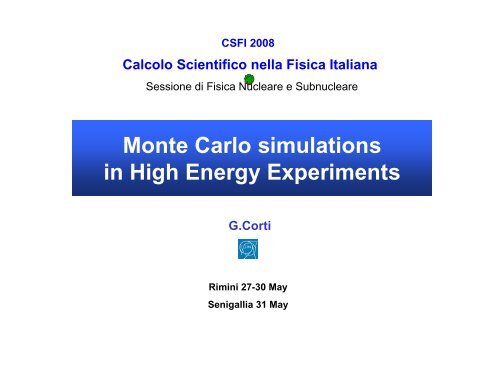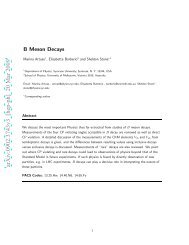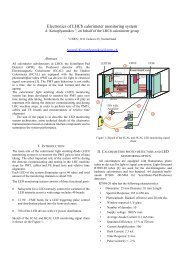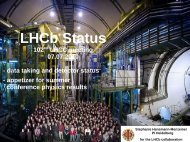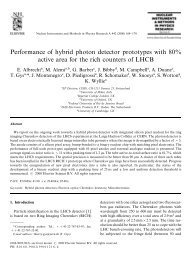Monte Carlo simulations in High Energy Experiments - LHCb - Cern
Monte Carlo simulations in High Energy Experiments - LHCb - Cern
Monte Carlo simulations in High Energy Experiments - LHCb - Cern
Create successful ePaper yourself
Turn your PDF publications into a flip-book with our unique Google optimized e-Paper software.
CSFI 2008<br />
Calcolo Scientifico nella Fisica Italiana<br />
Sessione di Fisica Nucleare e Subnucleare<br />
<strong>Monte</strong> <strong>Carlo</strong> <strong>simulations</strong><br />
<strong>in</strong> <strong>High</strong> <strong>Energy</strong> <strong>Experiments</strong><br />
G.Corti<br />
Rim<strong>in</strong>i 27-30 May<br />
Senigallia 31 May
Outl<strong>in</strong>e<br />
Introduction<br />
Why and how <strong>Monte</strong> <strong>Carlo</strong> <strong>simulations</strong> are used <strong>in</strong> <strong>High</strong> <strong>Energy</strong><br />
<strong>Experiments</strong><br />
Walk through the various aspects covered by MC <strong>simulations</strong> <strong>in</strong><br />
experiments<br />
Generation<br />
Track<strong>in</strong>g<br />
Detector response<br />
How does it all fit together<br />
<strong>LHCb</strong> example<br />
Statistics and CPU<br />
CSFI 2008 - Rim<strong>in</strong>i, 27 May 2008 G.Corti<br />
Page 2
Introduction<br />
In <strong>High</strong> <strong>Energy</strong> <strong>Experiments</strong> when<br />
elementary particles collides <strong>in</strong><br />
accelerators (for example)<br />
unstable particles are created, these<br />
particles decay quickly.<br />
it is necessary to reconstruct an<br />
“image” of the event through<br />
measurements by complex detectors<br />
compris<strong>in</strong>g many subdetectors.<br />
The <strong>Monte</strong> <strong>Carlo</strong> simulation role is to<br />
mimic what happens <strong>in</strong> the<br />
spectrometers to understand<br />
experimental conditions and<br />
performance.<br />
<strong>Monte</strong> <strong>Carlo</strong> data processed as real<br />
data <strong>in</strong> Reconstruction and Physics<br />
Analysis<br />
BUT we know the “truth”<br />
Compar<strong>in</strong>g the simulation with what is<br />
measured <strong>in</strong> reality we can <strong>in</strong>terpret<br />
the results<br />
<strong>Monte</strong> <strong>Carlo</strong><br />
Event Generation<br />
Track<strong>in</strong>g particles<br />
through material<br />
Detector Response<br />
Detector<br />
Reconstruction<br />
Physics Analysis<br />
CSFI 2008 - Rim<strong>in</strong>i, 27 May 2008 G.Corti<br />
Page 3<br />
DAQ system<br />
<strong>High</strong> Level Trigger
Why to use <strong>Monte</strong> <strong>Carlo</strong> <strong>simulations</strong><br />
Want to generate events <strong>in</strong> as much detail as Mother Nature<br />
get average and fluctuations right<br />
make random choices, ~ as <strong>in</strong> nature<br />
an event with n particles <strong>in</strong>volves O(10n) random choices<br />
multiple variables: flavour, mass, momentum, sp<strong>in</strong>, production vertex, lifetime,...<br />
At LHC: ~ 100 charged and ~ 200 neutral (+ <strong>in</strong>termediate stages)<br />
several thousand choices<br />
This applies also to the transport code through the spectrometer and the detectors<br />
response<br />
want to “track” the particles <strong>in</strong> the geometrical setup and have them <strong>in</strong>teract with the<br />
matter<br />
energy loss, multiple scatter<strong>in</strong>g, magnetic field<br />
want to simulate the detection processes and response of a given detector<br />
ionization, sc<strong>in</strong>tillation, light<br />
the <strong>in</strong>teraction events are stochastic and so is the transport process<br />
A problem well suited for <strong>Monte</strong> <strong>Carlo</strong> method <strong>simulations</strong><br />
computational algorithms rely<strong>in</strong>g on repeated random sampl<strong>in</strong>g to compute their results<br />
In fact a <strong>Monte</strong> <strong>Carlo</strong> simulation <strong>in</strong> a <strong>High</strong> <strong>Energy</strong> Experiment is a collection of<br />
different <strong>Monte</strong> <strong>Carlo</strong>, each specialized <strong>in</strong> a given doma<strong>in</strong>, work<strong>in</strong>g together to<br />
provide the whole picture<br />
CSFI 2008 - Rim<strong>in</strong>i, 27 May 2008 G.Corti<br />
Page 4
How are MC <strong>simulations</strong> used ?<br />
Detailed <strong>simulations</strong> are part of<br />
HEP physics<br />
Simulations are present from the<br />
beg<strong>in</strong>n<strong>in</strong>g of an experiment<br />
Simple estimates needed for<br />
mak<strong>in</strong>g detector design choices<br />
Develop reconstruction and<br />
analysis programs<br />
Evaluate physics reach<br />
We build them up over time<br />
Add<strong>in</strong>g/remov<strong>in</strong>g details as we go<br />
along<br />
We use them <strong>in</strong> many different<br />
ways<br />
Detector performance studies<br />
Provid<strong>in</strong>g efficiency, purity values<br />
for analysis<br />
Look<strong>in</strong>g for unexpected effects,<br />
backgrounds<br />
When theory is non well known<br />
compare to various models and<br />
accounts for different detector<br />
“acceptance”<br />
-<br />
bb angular production<br />
MC Data<br />
B J/Ψ K*<br />
CSFI 2008 - Rim<strong>in</strong>i, 27 May 2008 G.Corti<br />
3<br />
θb [rad]<br />
2<br />
1<br />
0<br />
1<br />
2<br />
3<br />
θb [rad]<br />
Page 5<br />
shape of the detector
Traditional flow of simulated data and applications<br />
Generators<br />
<strong>LHCb</strong> example<br />
Geometry<br />
Simulation<br />
Specific<br />
reaction<br />
Response<br />
Simulation<br />
Particle<br />
paths<br />
Reconstruction<br />
Two <strong>in</strong>dependent phases that<br />
can be split<br />
Recorded<br />
signals<br />
Physics Tools<br />
Observed<br />
tracks, etc<br />
DAQ<br />
system<br />
Interpreted<br />
events<br />
Individual<br />
Analyses<br />
CSFI 2008 - Rim<strong>in</strong>i, 27 May 2008 G.Corti<br />
Page 6
<strong>Experiments</strong> simulation software<br />
HEP experiments have their own software frameworks and use external<br />
packages developed <strong>in</strong> the physics community for Generators and for<br />
Transport <strong>in</strong> the detectors<br />
Athena (ATLAS), CMSSW (CMS), Gauss (<strong>LHCb</strong>), VMC (ALICE, CBM@GSI,<br />
M<strong>in</strong>os), bbsim (BaBar), etc.<br />
Response of the detectors is often <strong>in</strong>-”house” and requires detectors<br />
experts<br />
tuned first with test beam data, then with measurements <strong>in</strong> the experiment<br />
Experiment applications provide<br />
Interfaces to event generators<br />
Interface to transport code<br />
Event model for MC truth and Persistency<br />
Access to snap-shots of process to understand what happened<br />
Histograms, messag<strong>in</strong>g<br />
Physicists <strong>in</strong> the experiments are shielded from Generators and transport<br />
code (eg. Geant4) to different degrees<br />
different <strong>in</strong> the various experiments<br />
different for different roles<br />
CSFI 2008 - Rim<strong>in</strong>i, 27 May 2008 G.Corti<br />
Page 7
Structure of a simulation application<br />
Initialize<br />
Gauss the <strong>LHCb</strong> simulation application as example<br />
JobOpts<br />
Interface<br />
Pythia,<br />
EvtGen<br />
…<br />
Event Generation<br />
primary event generator<br />
specialized decay package<br />
pile-up generation<br />
Exchange<br />
model<br />
HepMC<br />
GiGa<br />
Geant4<br />
Detector Simulation<br />
geometry of the detector (<strong>LHCb</strong> Geant4)<br />
track<strong>in</strong>g through materials (Geant4)<br />
hit creation and MC truth <strong>in</strong>formation (Geant4 <strong>LHCb</strong>)<br />
CSFI 2008 - Rim<strong>in</strong>i, 27 May 2008 G.Corti<br />
Cnv<br />
JobOpts<br />
Cnv<br />
Geometry<br />
Cnv<br />
<strong>LHCb</strong><br />
Event<br />
model<br />
HepMC<br />
MCParticle<br />
MCVertex<br />
MCHits<br />
POOL<br />
Page 8<br />
Two INDEPENDENT phases normally run <strong>in</strong> sequence <strong>in</strong> a s<strong>in</strong>gle job<br />
Monitor<br />
Initialize<br />
Monitor
Event generation<br />
Many programs available <strong>in</strong> the physics community to generate primary<br />
collisions<br />
specialized for hard processes, resonance, decays, parton showers,<br />
hadronization, etc.<br />
often best at given task, but not always directly usable by experiments<br />
general-purpose<br />
PYTHIA (T.Sijostrand et al.)<br />
HERWIG (G.Marches<strong>in</strong>i et al.)<br />
ISAJET (H.Baer et al.)<br />
SHERPA (F.Kraus et al.)<br />
LCG Generators Service at CERN provides libraries for many of them<br />
– http://lcgapp.cern.ch/project/simu/generator/<br />
<strong>Experiments</strong> generally use one generator for massive production and<br />
make smaller data sets with others<br />
Pythia/Herwig have different hadronisation mechanism (clusters as opposed to<br />
str<strong>in</strong>gs) for example<br />
and specialized codes when necessary<br />
BaBar and <strong>LHCb</strong> use EvtGen (D.Lange and A.Ryd) for b-hadrons decays<br />
ATLAS and CMS use MCatNLO (S.Frixione, B.Webber) , AlpGen (M.Mangano et al) for<br />
matrix elements to feed to general purpose<br />
ALICE uses Hiij<strong>in</strong>g (M.Gyulassy and X.-N. Wang) for Pb-Pb <strong>in</strong>teraction<br />
CSFI 2008 - Rim<strong>in</strong>i, 27 May 2008 G.Corti<br />
Page 9
Generator phase <strong>in</strong> practice<br />
In <strong>LHCb</strong> as example <strong>in</strong> Gauss<br />
proton-proton <strong>in</strong>teractions at E cm =<br />
14 TeV are generated us<strong>in</strong>g Pythia<br />
6<br />
First simulate the hard processes <strong>in</strong><br />
collid<strong>in</strong>g particles, then the<br />
subsequent hadronisation<br />
LHAPDF for Parton Density<br />
Functions<br />
particles are then decayed by<br />
EvtGen (+PHOTOS and Pythia)<br />
Various type of events generated<br />
M<strong>in</strong>imum bias<br />
<strong>in</strong>cludes hard QCD processes, s<strong>in</strong>gle<br />
and double diffractive events<br />
Signal b and bb events<br />
obta<strong>in</strong>ed from m<strong>in</strong>imum bias events<br />
with b or b-hadron<br />
Cosmics and “particle guns (ie. a<br />
given particle with given<br />
k<strong>in</strong>ematic)”<br />
Choose Pythia sett<strong>in</strong>g that would agree with<br />
experiments measured particle multiplicities<br />
Simulate runn<strong>in</strong>g conditions<br />
Lum<strong>in</strong>ous region with smear<strong>in</strong>g<br />
of primary vertex accord<strong>in</strong>g to<br />
bunch sizes<br />
CSFI 2008 - Rim<strong>in</strong>i, 27 May 2008 G.Corti<br />
Page 10<br />
Pileup (number of pp<br />
collisions per bunch)<br />
at runn<strong>in</strong>g lum<strong>in</strong>osity
Detectors simulation, eg. the LHC experiments<br />
ALICE<br />
CMS<br />
Solenoid and dipole magnets<br />
ATLAS<br />
<strong>LHCb</strong><br />
Toroid and Solenoid magnets<br />
45m long, 25m diameter<br />
Solenoid magnet<br />
22m long, 15m diameter Dipole magnet<br />
22m long, up to 10 m height<br />
CSFI 2008 - Rim<strong>in</strong>i, 27 May 2008 G.Corti<br />
Page 11
Transport through detectors<br />
Complex detectors and a large variety of physics processes that<br />
need to be simulated<br />
Closer to pp<br />
collision<br />
Photons<br />
e ±<br />
Muons<br />
π ± , p, K ±<br />
Neutrons<br />
Track<strong>in</strong>g detectors<br />
Electromagnetic calorimeter<br />
and special particle ID detectors<br />
(eg. R<strong>in</strong>g Imag<strong>in</strong>g Cerenkov)<br />
Farther to pp<br />
collision<br />
Hadronic calorimeter<br />
Muon detectors<br />
π ± , p, K ±<br />
Photons<br />
Neutrons<br />
CSFI 2008 - Rim<strong>in</strong>i, 27 May 2008 G.Corti<br />
e ±<br />
Muons<br />
At LHC particle energies range from few<br />
MeV to TeV<br />
What is signal for one detector can be<br />
background for another<br />
HEP <strong>Experiments</strong> use <strong>in</strong> their framework packages developed <strong>in</strong> the<br />
physics community for transport of particles: GEANT4 and/or FLUKA<br />
Page 12
Detector simulation: transport codes<br />
GEANT4 is a C++ toolkit to track particles through the detector developed<br />
<strong>in</strong> the Physics community<br />
GEANT4 International Collaboration ~ 10 year old<br />
used <strong>in</strong> HEP, nuclear physics, heavy ion physics, cosmic ray physics,<br />
astrophysics, space science and medical applications<br />
GEANT4 is the successor of GEANT3, the world-standard toolkit for HEP<br />
detector simulation<br />
http://geant4.web.cern.ch/geant4/<br />
All LHC experiments use GEANT4 for transport<strong>in</strong>g particles <strong>in</strong> the<br />
experimental setup and simulat<strong>in</strong>g the physics processes that can occur<br />
Navigation <strong>in</strong> EM fields<br />
Physics processes for a variety of particles at different energies<br />
ALICE also uses FLUKA (A.Ferrari et al)<br />
FORTRAN-based<br />
Couples low energy neutron transport and particle transport<br />
Other LHC experiments use it radiation levels<br />
CSFI 2008 - Rim<strong>in</strong>i, 27 May 2008 G.Corti<br />
Page 13
Detector simulation: Geant 4<br />
GEANT4 coverage of physics comes from mixture of theorydriven,<br />
parameterized, and empirical formulae. Both crosssections<br />
and models (f<strong>in</strong>al state generation) can be comb<strong>in</strong>ed <strong>in</strong><br />
arbitrary manners as necessary.<br />
Standard and Low energy EM processes, Hadronic processes,<br />
Optical photon processes, Decay processes, etc.<br />
Each particle is moved <strong>in</strong> steps (few microns to cm)<br />
For each step:<br />
The material the particle is <strong>in</strong> is found<br />
The energy loss and directional change due to multiple scatter<strong>in</strong>g is<br />
applied<br />
The effects of electric and magnetic fields on charged particles are<br />
calculated<br />
The particle might generate photons by bremstrahlung or Cherenkov<br />
radiation<br />
The particle might decay <strong>in</strong> flight<br />
The particle might collide with a nucleus and generate more particles<br />
If the particle enters or leaves a detector it is recorded<br />
CSFI 2008 - Rim<strong>in</strong>i, 27 May 2008 G.Corti<br />
Page 14
EM and hadronic showers <strong>in</strong> material<br />
Hadronic shower<br />
shapes<br />
Electro-magnetic<br />
showers<br />
In dense material<br />
number of particles<br />
created and tracked by<br />
Geant grows quickly<br />
and with that the CPU<br />
time!<br />
CSFI 2008 - Rim<strong>in</strong>i, 27 May 2008 G.Corti<br />
Page 15<br />
Atlas event from their publicity page
Geometry model<strong>in</strong>g<br />
Need accurate model<strong>in</strong>g to have the most accurate results<br />
but more volumes, more memory, more CPU time<br />
A wide variety of dimensions <strong>in</strong> an HEP experiment<br />
Choose depend<strong>in</strong>g on relevance to physics study<br />
<strong>LHCb</strong><br />
<strong>LHCb</strong><br />
For trackers detailed description of all active<br />
and passive components; material budget<br />
CSFI 2008 - Rim<strong>in</strong>i, 27 May 2008 G.Corti<br />
Page 16<br />
VErtex LOcator
Physics processes and cuts<br />
Need to describe physics processes as accurate as needed<br />
by resolution of detectors<br />
Choose appropriate physics models and set cuts: more accuracy more CPU<br />
CMS: Pion HCAL<br />
Longitud<strong>in</strong>al Shower Profile<br />
E=300 GeV<br />
In <strong>LHCb</strong> full simulation QGSP<br />
takes ~ 10% longer that LHEP<br />
Tim<strong>in</strong>g Performance vs Range Cut<br />
V. Ivanchenko, Geant4<br />
CSFI 2008 - Rim<strong>in</strong>i, 27 May 2008 G.Corti<br />
Page 17
Simulation of Detector response (aka digitization)<br />
Simulation of detector response<br />
transform<strong>in</strong>g hits <strong>in</strong> sensitive<br />
detectors to produce digitized<br />
data and provide them <strong>in</strong> DAQlike<br />
format is provided by<br />
separate application<br />
Convenience<br />
Flexibility<br />
Each detector has its own<br />
detailed detector response<br />
simulation and imperfections<br />
Detections efficiencies and<br />
resolutions are adjusted<br />
accord<strong>in</strong>g to test beam data<br />
Electronic noise and cross-talk<br />
for each specific detector are<br />
added<br />
Time <strong>in</strong>formation is correctly<br />
taken <strong>in</strong>to account by all<br />
detectors<br />
Handl<strong>in</strong>g of spill-over effects<br />
(data from adjacent beam<br />
cross<strong>in</strong>gs)<br />
A detector is sensitive to<br />
previous or subsequent bunch<br />
cross<strong>in</strong>gs depend<strong>in</strong>g on its<br />
electronics<br />
<strong>LHCb</strong>, Boole output<br />
In <strong>LHCb</strong> last proceess<strong>in</strong>g of Boole is the L0<br />
harwdare trigger emulation<br />
CSFI 2008 - Rim<strong>in</strong>i, 27 May 2008 G.Corti<br />
Page 18
Statistics and CPU time<br />
Statistics required of the same order of real events<br />
for LHC feasible for signal (O(10)-O(10 6 )/year), even many times more.<br />
while impossible for all pp collisions (O(10 7 )-O(10 8 )/sec) months of runn<strong>in</strong>g<br />
on the GRID to generate few seconds generic b events of LHC(b) data tak<strong>in</strong>g<br />
Simulations are the most CPU time consum<strong>in</strong>g applications of HEP<br />
experiments<br />
<strong>in</strong> <strong>LHCb</strong> the simulation takes 50 + 1 KSI2k sec/event (Gauss + Boole)<br />
while the reconstruction takes 2.5 KSI2k sec/event<br />
Transport through the detectors is the longest<br />
<strong>in</strong> <strong>LHCb</strong>: generator phase 1/100 th of simulation phase<br />
The CPU time depends on the complexity of the primary events<br />
<strong>LHCb</strong>: m<strong>in</strong>imum bias 20 KSI2k sec/event<br />
generic b events 50 KSI2k sec/event<br />
ALICE: pp collisions 39 KSI2k sec/event<br />
Pb-Pb collisions 7000 KSI2k sec/event with tricks to save time<br />
Require a production system and GRID resources to simulate events<br />
<strong>in</strong> LHC experiment comput<strong>in</strong>g model Tier2 are used to produce them and Tier1<br />
to store the output data<br />
ensure non-overlap of samples with control of random number generators<br />
seeds<br />
CSFI 2008 - Rim<strong>in</strong>i, 27 May 2008 G.Corti<br />
Page 19
Simplify simulation by cross<strong>in</strong>g levels<br />
Generators<br />
Advantages:<br />
Specific<br />
reaction<br />
parameterized<br />
simulation<br />
Fast and flexible for “what if” analysis studies<br />
Reta<strong>in</strong>s flexibility to choose generators<br />
Disadvantages<br />
Often not sufficiently realistic<br />
Only certa<strong>in</strong> <strong>in</strong>formation, tools available<br />
Can use similar techniques at other levels<br />
Interpreted<br />
events<br />
Individual<br />
Analyses<br />
eg. Atlfast<br />
(ATLAS)<br />
CSFI 2008 - Rim<strong>in</strong>i, 27 May 2008 G.Corti<br />
Page 20
Conclusions<br />
Events studied <strong>in</strong> <strong>High</strong> <strong>Energy</strong> Physics experiments at more and<br />
more complex. With LHC very high energy will be reached.<br />
Simulations of such events are an <strong>in</strong>tegral part of an experiment <strong>in</strong><br />
all of its phases from design to physics analysis<br />
Simulations applications are a complex system of dedicated<br />
software developed by the physics community and by the<br />
experiments<br />
Considerable comput<strong>in</strong>g resources are (and will be) necessary:<br />
the GRID is already extensively used for this<br />
CSFI 2008 - Rim<strong>in</strong>i, 27 May 2008 G.Corti<br />
Page 21


